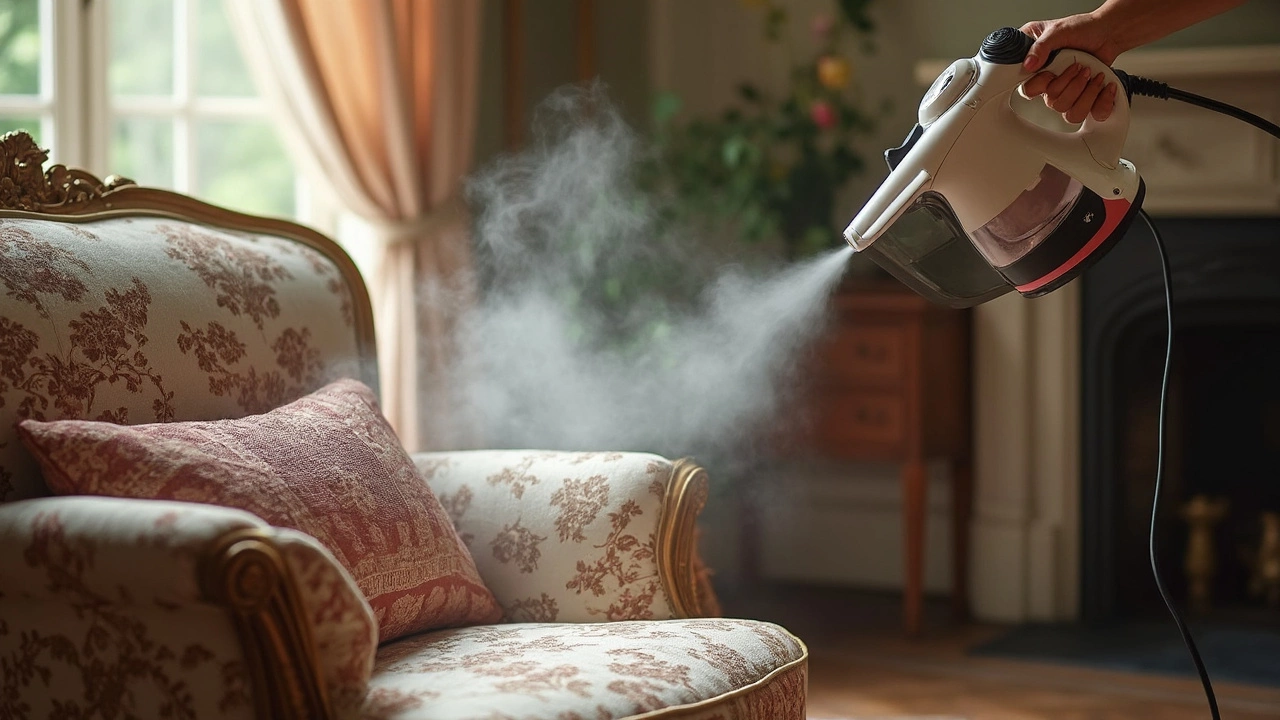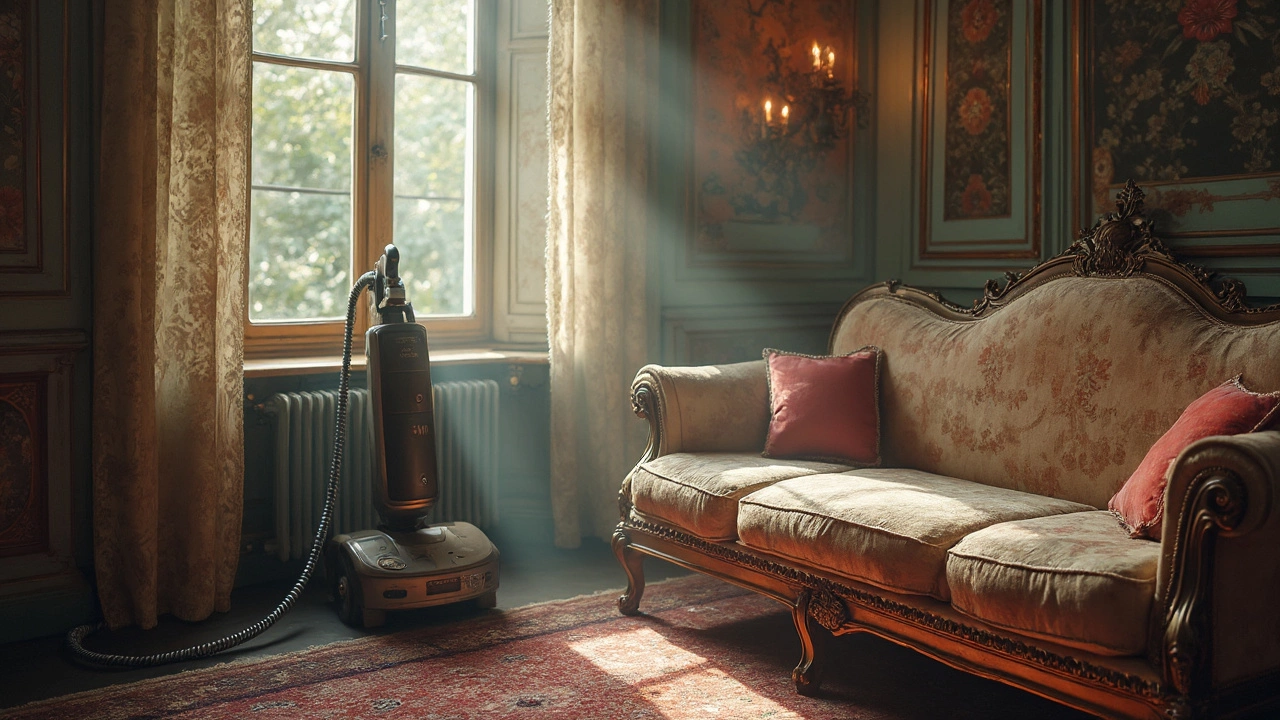Ever thought about using steam to freshen up your couch or chairs? It sounds great, right? A quick blast of hot steam and, bam, dirt and germs are supposed to vanish. But hang on a second before you get trigger-happy with that steam cleaner. There are a few things you need to know if you don’t want to end up with a soggy, faded, or even damaged piece of furniture.
First off, not every fabric gets along with steam. Some are super sensitive to high heat and moisture, which could lead to shrinkage or texture changes. Picture working hard, only to end up with a puckered or distorted seat cover. Not a win-win!
Then, there's the issue of moisture. Sure, steam cleaners are meant to use very little of it, but ‘little’ can be subjective. Too much moisture can seep into cushions, taking forever to dry and inviting mold or mildew to the party if you’re not careful.
- Steam vs. Fabric Sensitivity
- Moisture Matters
- Color Fade Concerns
- Risk of Mold and Mildew
- Shoot for Safety
- Alternatives and Tips
Steam vs. Fabric Sensitivity
When it comes to steam cleaning your upholstery, not all fabrics respond in the same way. It's like how some people are cool with spicy food while others can't handle the heat. Your furniture's fabric might have a similar reaction to steam. The temperature and moisture involved in steam cleaning can be a bit too much for certain materials, leaving them shriveled or even discolored.
Let’s break down the common culprits:
- Natural fibers like cotton or wool can be especially tricky. Cotton is prone to shrinking if it's exposed to high temperatures, while wool may lose its texture and robustness.
- Silk and velvet are big no-nos for steam cleaning. They're delicate and the steam can change their luxurious texture, leaving them looking flat and worn out.
- For synthetic fabrics like polyester or nylon, you're usually safer, but it’s always worth checking the manufacturer's care instructions. Even synthetics can have limits.
An important tip here is to always spot test. It's like trying out a new skincare product on a small patch before slathering it all over. Pick a hidden area of your furniture and test the steam there first.
Also, be mindful of the type of steamer you're using. Some models offer adjustable steam levels. Dial it down for sensitive fabrics if you still decide to go ahead with steam cleaning.
Remember, prevention is better than cure. Knowing your fabric and using the right cleaning method can save you from regretting a cleaning disaster down the road.
Moisture Matters
When it comes to steam cleaning, moisture is both a friend and a foe. While it’s key to loosening dirt, too much can spell trouble for your upholstery. One of the biggest mistakes is letting excessive moisture linger, which can lead to deep-seated problems.
Moisture Overload Risks
Using a steam cleaner on upholstered furniture is a balancing act. The ideal is to use just enough steam to clean, without soaking the fabric. Overdo it, and the moisture might seep into the cushions. This can cause your furniture to stay damp for far too long.
Why's that bad? Well, lingering moisture can promote mold and mildew growth. These unpleasant guests love damp environments. Aside from being unsightly, they produce allergens that could be a health risk for your household.
Drying Hacks
So, how do you avoid these issues? One good practice is to constantly keep the steam cleaner moving. Don't hover over one spot for too long. Also, cracking open a window or turning on a fan can help speed along the drying process, providing better airflow.
For humid climates, consider using a dehumidifier post-cleaning to help pull that excess moisture out of the air, and away from your precious couch.
Getting the Balance Right
Consider testing your cleaner's moisture levels first. Before jumping in, run the cleaner over a less noticeable area of the upholstery. This allows you to see how the fabric reacts before committing to the entire piece.
Avoiding excessive moisture is crucial. Nobody wants to clean their couch only to notice a lingering damp smell a few days later. Pay attention to these details, and your upholstery cleaning will be both effective and safe!
Color Fade Concerns
Ever notice how your favorite old shirt looks a bit less vibrant after a few too many washes? The same thing can happen to your upholstery with steam cleaning. It's a real bummer when your vibrant sofa starts looking washed out, all because of a cleaning method that seemed harmless at first.
For starters, the high temperatures involved in steam cleaning can be harsh on dyes used in many upholstery fabrics. Over time, repeated exposure can draw out those rich colors, leaving your furniture looking a little dull and tired.
Understanding Colorfastness
Colorfastness is a fancy term that basically means resistant to discoloration or fading. Not all fabrics are colorfast, meaning some could easily lose their hues when exposed to hot steam. If your upholstery isn't colorfast, you’re looking at a recipe for faded disappointment.
Here's a quick tip before you dive into steam cleaning: always test a small hidden area first. This isn't foolproof, but it can help you avoid a full disaster with a living room centerpiece.
What Experts Say
According to some upholstery experts, fabrics like velvet, silk, and some cotton blends are often at higher risk. These fancy materials soak up steam and heat, leading to possible color fading. Paying special attention to your fabric type can save you the headache of unexpected discoloration.
Protecting Your Upholstery
- Use a steam cleaner with variable heat settings so you can lower the temperature.
- Consider using a fabric protector after cleaning to lock in colors.
- If you're unsure, consult a professional upholstery cleaner who knows which methods are safest for your material.
The takeaway? While steam cleaning can work wonders in many cases, it's essential to be aware of the specific sensitivities of your upholstery. Understanding these quirks helps you keep your furniture looking its best.

Risk of Mold and Mildew
Mold and mildew can be your upholstery's worst nightmare when you're dealing with too much moisture from steam cleaning. Although using a steam cleaner seems harmless, if the surface doesn't dry properly, you're setting the stage for unwanted guests—mold and mildew! These pesky issues don't just ruin the fabric; they can also affect indoor air quality.
Dr. Emily Reynolds, a microbiologist from the Indoor Environmental Institute, says,
"Without proper drying, upholstery can become a breeding ground for mold. Mold spores can spread rapidly and lead to health concerns, especially for those with existing respiratory conditions."
Moisture lurks beneath the fabric and cushions, which is why picking the right technique and ensuring complete drying are crucial steps. Even if the top layer feels dry, deeper layers might still be damp. Factors like room temperature and humidity levels can influence how fast things dry.
Quick Tips to Prevent Mold After Steam Cleaning
- Adequate Ventilation: Open windows or use fans. Circulating air helps evaporate moisture faster.
- Spot Check: Leave a tissue under a cushion. If it comes out damp after a few hours, more drying is needed.
- Use a Dehumidifier: Set one up in the room to suck out excess moisture and speed up the drying process.
If you're aiming to prevent upholstery cleaning hiccups, always test a small area first. And let's not forget, sometimes traditional methods like vacuuming or professional cleaning might suit your furniture better!
Shoot for Safety
When diving into the world of steam cleaning, safety isn't just a nice-to-have. It's a must. We're not just talking about keeping your fingers away from hot steam; there's a bit more to it. Here's how you can stay on the safe side while cleaning your furniture.
Test Before You Steam
Before pointing that powerful cleaner at your favorite chair, do a quick test patch. Pick a hidden spot and give it a light steam. Check back in a few hours to make sure the fabric hasn't reacted in some wacky way. If it looks good, you're likely in the clear.
Mind the Tags
Those little tags on your upholstery can be super helpful. Look for information on whether your specific fabric type can handle steam cleaning. When in doubt, err on the side of caution.
Keep It Moving
It's not just about blasting and hoping for the best. Move the cleaner slowly and steadily over your surface, ensuring you don't soak one area too much. Too much steam could lead to trouble like fading or even more moisture than your couch can handle.
Measure Moisture
Moisture content can be a sneaky culprit causing mold and mildew. Consider investing in a moisture meter if you’re a regular cleaner, just to make sure that post-clean job is as dry as it feels.
Remember, knowing about the risks and taking straightforward steps can turn steam cleaning from a risk into a rewarding experience.
Alternatives and Tips
So, maybe you're now having second thoughts about steam cleaning your upholstery. That’s cool because there are other ways to keep your furniture looking sharp without a single puff of steam.
Dry Cleaning Solutions
For those delicate fabrics that might wrinkle at the thought of moisture, dry cleaning solutions can be a lifeline. These usually come as sprays that need a good shake before use. Simply spray lightly and then blot with a clean cloth. It's quick and works wonders without needing water.
Vacuuming
Never underestimate the power of a good vacuum. Regularly vacuuming your upholstery can keep dust and crumbs at bay. It’s a simple, non-invasive method to maintain cleanliness without stressing the fabric.
Baking Soda Magic
Baking soda isn’t just for the kitchen. Sprinkle it over your upholstery, let it sit for about 15 minutes, then vacuum it up. It’s an excellent option for removing odors and giving your furniture a fresh feel.
Homemade Upholstery Cleaner
If you’re into DIY, try mixing a bit of dish soap with warm water. Use a microfiber cloth to dab, not drench, the mixture onto stains. Gently blot until the spot lifts. Just be sure to test it first to avoid any unwanted surprises.
Use Professional Services
If your couch is precious and you’re hesitant to DIY, calling in a pro might be wise. Professional upholstery cleaners have equipment and know-how that can save time and prevent headaches. It might be a bit pricier, but it’s a fantastic option if you want peace of mind.
| Method | Works Best For | Notes |
|---|---|---|
| Dry Cleaning Spray | Delicate Fabrics | Test on a small area first |
| Vacuuming | Daily Maintenance | Remove crumbs and dust |
| Baking Soda | Odor Removal | Avoid overuse on dark fabrics |
| Homemade Cleaners | Spot Cleaning | Test before use |
| Professional Services | Valuable Pieces | Saves time and effort |
Whichever route you choose, keep in mind the type and age of your upholstery. The key is matching the right method to what you’ve got sitting in your living room. If managed well, these alternatives can prolong the life and look of your upholstery without diving into steam.
